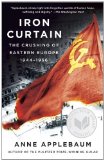Summary | Excerpt | Reviews | Beyond the Book | Readalikes | Genres & Themes | Author Bio

Critics' Opinion:
Readers' Opinion:
First Published:
Oct 2012, 608 pages
Paperback:
Aug 2013, 640 pages
 Book Reviewed by:
Book Reviewed by:
Kim Kovacs
Buy This Book
Free elections held in some countries in 1945 and 1946 were not a sign of communist tolerance either. The Soviet and Eastern European communist parties allowed these elections to happen because they thought that with control over the secret police and the radio, and with heavy influence over young people, they would win. Communists everywhere believed in the power of their own propaganda, and in the first years after the war's end they had some good reasons for that belief. People did join the party after the war, whether out of despair, disorientation, pragmatism, cynicism or ideology, not only in Eastern Europe but in France, Italy and Britain. In Yugoslavia, Tito's communist party was genuinely popular, thanks to its role in the resistance. In Czechoslovakia – occupied by Hitler in 1938, thanks to the appeasement of the West – real hopes were at first placed in the Soviet Union, which the Czechoslovaks hoped would be a more sympathetic power. Even in Poland and Germany, countries where suspicion of Soviet motives was strong, the psychological impact of the war also shaped many people's perceptions. Capitalism and liberal democracy had failed catastrophically in the 1930 s. Many believed it was now time to try something different.
Hard though it is sometimes for us to understand, communists also believed their own doctrine. Just because communist ideology now seems wrongheaded in retrospect, that doesn't mean it didn't inspire fervent belief at the time. The majority of communist leaders in Eastern Europe – and many of their followers – really did think that sooner or later the working-class majority would acquire class consciousness, understand its historical destiny, and vote for a communist regime. They were wrong. Despite intimidation, despite propaganda and despite even the real attraction communism held for some people devastated by the war, communist parties lost early elections in Germany, Austria and Hungary by large margins. In Poland, the communists tested the ground with a referendum, and when that went badly its leaders abandoned free elections altogether. In Czechoslovakia, the communist party did well in an initial set of elections, in 1946 , winning a third of the vote. But when it became clear that it would do much worse in subsequent elections in 1948 , party leaders staged a coup. The harsher policies imposed upon the Eastern bloc in 1947 and 1948 were therefore not merely, and certainly not only, a reaction to the Cold War. They were also a reaction to failure. The Soviet Union and its local allies had failed to win power peacefully. They had failed to achieve absolute or even adequate control. Despite their infl uence over the radio and the secret police, they were not popular or universally admired. The number of their followers was shrinking rapidly, even in countries like Czechoslovakia and Bulgaria, where they had initially had some genuine support. As a result, the local communists, advised by their Soviet allies, resorted to harsher tactics which had been used previously – and successfully – in the USSR . The second part of this book describes those techniques: a new wave of arrests, the expansion of labour camps, much tighter control over the media, intellectuals and the arts. Certain patterns were followed almost everywhere: fi rst the elimination of 'right-wing' or anti-communist parties, then the destruction of the non-communist left, then the elimination of opposition within the communist party itself. In some countries, communist authorities even conducted show trials very much along Soviet lines. Eventually the region's communist parties would attempt to eliminate all remaining independent organizations; to recruit followers into state-run mass organizations instead; to establish much harsher controls over education; to subvert the Catholic and Protestant churches. They created new, all-encompassing forms of educational propaganda, sponsored public parades and lectures, hung banners and posters, organized petition-signing campaigns and sporting events.
Excerpted from Iron Curtain by Anne Applebaum. Copyright © 2012 by Anne Applebaum. Excerpted by permission of Doubleday. All rights reserved. No part of this excerpt may be reproduced or reprinted without permission in writing from the publisher.





The Funeral Cryer by Wenyan Lu
Debut novelist Wenyan Lu brings us this witty yet profound story about one woman's midlife reawakening in contemporary rural China.
Your guide toexceptional books
BookBrowse seeks out and recommends the best in contemporary fiction and nonfiction—books that not only engage and entertain but also deepen our understanding of ourselves and the world around us.